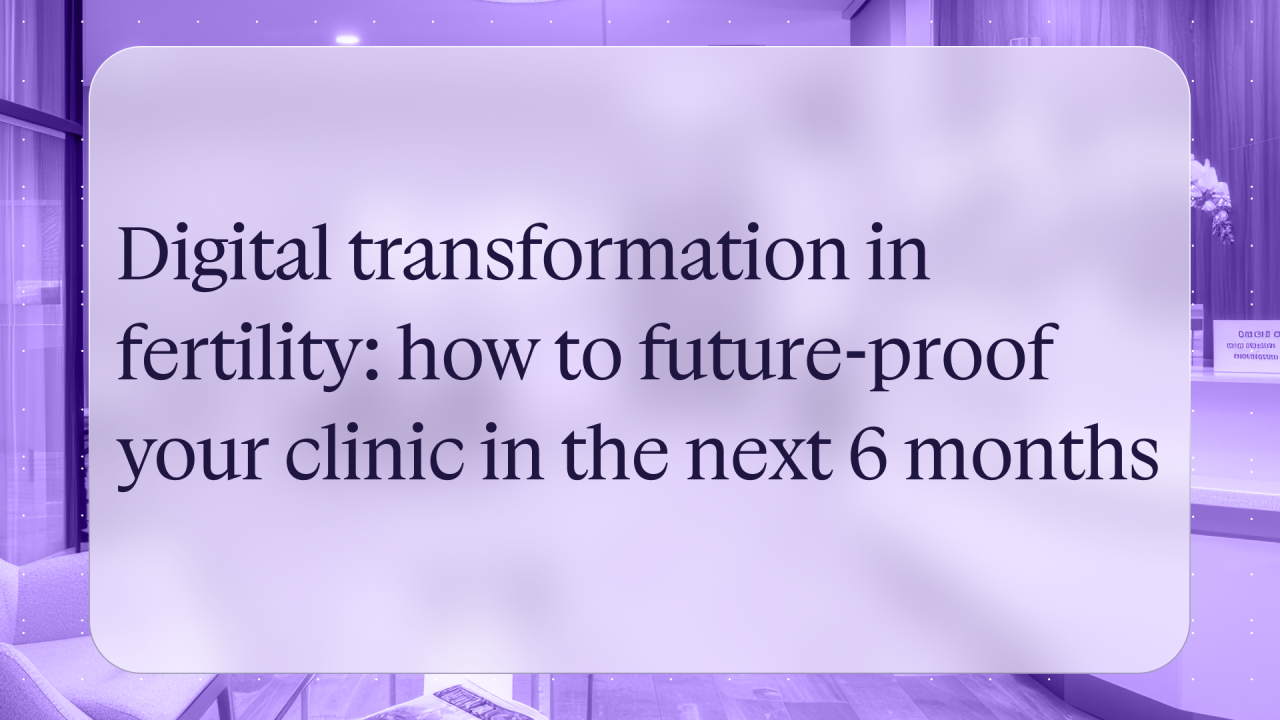Digital transformation in fertility: How to future-proof your clinic in the next 6 months

Digital transformation can feel like a daunting prospect for fertility clinics.
It’s often associated with large-scale tech overhauls, expensive infrastructure, and months of disruption. But in reality, some of the most effective transformations start small—and make an impact fast.
Over the past six weeks, we’ve explored how digital tools can improve operations, reduce admin pressure, and support patients more effectively. Now, we bring those insights together with one simple question:
What can a fertility clinic realistically achieve in the next six months to move towards a more modern, patient-first, and future-ready system?
Start with visibility, not technology
Before you invest in new systems, you need a clear understanding of where things stand today. This starts by identifying the internal pressure points: where teams are losing time, where systems aren’t talking to each other, and where manual processes are causing friction.
It doesn’t require a consultant or a strategy document. A short, structured session with key staff, admin or clinical, can reveal where time is being wasted and where risk is quietly building up.
You’ll often find the same issues cropping up: repetitive form handling, delayed updates, missing handovers, or staff relying on memory to keep patient journeys on track.
Patients feel system gaps more than anyone
From the clinic’s perspective, systems might appear to be working. But patients often experience the gaps more acutely especially when they’re feeling anxious or vulnerable.
They notice when they’re asked the same questions multiple times. They feel it when updates are delayed or unclear. They lose confidence when different departments give different answers.
Understanding these patient-facing friction points is essential to knowing where to improve first. Your digital tools should enhance confidence, clarity and connection, not just efficiency.
Transformation happens one process at a time
While it’s tempting to look for an all-in-one solution, the most successful clinics start small and build momentum.
That could be:
- Automating appointment reminders to reduce no-shows
- Introducing digital onboarding forms to save staff time
- Implementing real-time consent tracking to reduce compliance risk
- Replacing email handovers with integrated task updates
These changes may seem incremental, but they can significantly reduce admin burden, improve communication, and give staff more time to focus on care.
Choose solutions designed for IVF care, not workarounds
Generic health tech platforms can seem attractive, but they often create new work for already stretched teams.
They require customisation, manual integration, or compromise.
Instead, clinics should look for tools that are built specifically for fertility:
- Seamless EMR integration
- Clear, patient-friendly communication features
- Automation designed for IVF workflows
- Secure consent and form management
- And above all, ease of use for both staff and patients
Choosing the right tools should be focused around finding the fit that works best for your team.
Bring your team with you
No matter how effective the technology, it won’t succeed without your team’s trust and buy-in.
Clinics that embed change successfully do one thing very well: they make sure the people using the system feel part of the process.
That means showing not just what is changing, but why. Framing improvements in terms of time saved, reduced admin, less confusion, and a better experience for both staff and patients.
Digital transformation isn’t about replacing the human element. It’s about creating space for it to thrive.
Set clear goals and track the progress
Digital transformation doesn’t need to be tied to complex KPIs or expensive analytics platforms. What matters most is clarity and knowing what success looks like for your clinic as well as how to recognise it when you see it.
Start by identifying 2–3 specific goals aligned with your biggest pain points. For example:
- Reduce patient follow-up emails by 30%
- Cut new patient onboarding time from 7 days to 3
- Ensure 100% of consents are submitted digitally and on time
- Increase the number of internal handovers managed through a central system
Once goals are set, check progress regularly. This could be as simple as:
- Asking staff where they’ve seen time savings
- Reviewing patient feedback for signs of improved communication
- Spot-checking process completion times week to week
You don’t need sophisticated reporting tools to know whether something’s working. You just need the discipline to observe, ask, and adjust.
Most importantly, celebrate early wins, no matter how small. Progress is motivating, and clear success stories help build momentum for the next stage of transformation.
Progress starts with one decision
Every clinic’s starting point is different. But whether you’re running a single-site practice or overseeing a network, the key to transformation is momentum.
It doesn’t require a complete overhaul. It requires a willingness to ask: What could we make better this month? And how can we make sure that change lasts?
At Salve, we don’t just offer patient apps, we partner with clinics to modernise operations, reduce cost-to-serve, and improve team performance.
Whether you’re digitising one process or scaling across multiple sites, we support you with the structure, tools, and expertise to make change stick.

.png)



.jpg)





